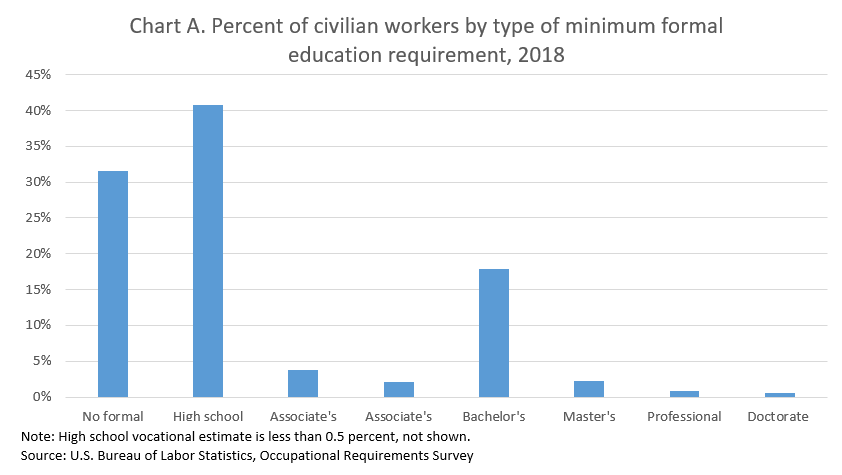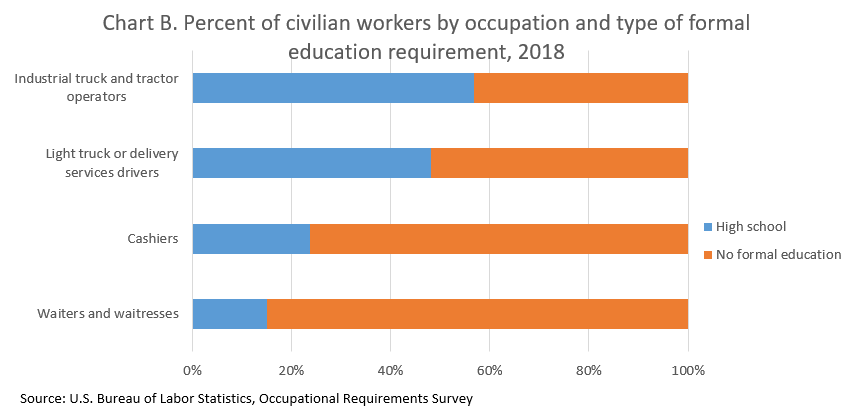An official website of the United States government
 United States Department of Labor
United States Department of Labor
The Occupational Requirements Survey (ORS) is designed to capture information regarding what is required of workers in order to successfully perform a job, and is not focused on the specific capabilities or experience of the worker. In terms of minimum education, ORS captures the minimum education required by the job, and not the educational attainment of the worker. For example, a job may require a bachelor’s degree, but a worker performing the job may have a doctoral degree. In this case, the ORS would capture the requirement of this particular job as a bachelor’s degree.
Information collected about minimum education requirements is one of four components used to ultimately calculate an occupation’s specific vocational preparation, or SVP. The SVP is determined by the amount of preparation time required by the job and includes pre-employment training, prior work experience, minimum formal education requirements, and post-employment training. Although these collected requirements are used to calculate the SVP estimates, the ORS also provides information on the individual components, including minimum formal education.
The minimum formal education requirements and the vocational time included in the SVP is shown below:
| Minimum education requirement | Vocational time included in SVP(1) |
|---|---|
|
No formal education required |
None |
|
High school |
None |
|
Vocational high school |
2 years |
|
Associate’s degree |
1 year |
|
Vocational associate’s |
2 years |
|
Bachelor’s degree |
2-3 years |
|
Master’s degree |
All post graduate years (usually 1-2 years) plus 2 years of bachelor’s |
|
Professional degree |
All post graduate years (usually 2-4 years) plus 2 years of bachelor’s |
|
Doctorate |
6 years (4 years post-graduate plus 2 years of bachelor’s) |
|
Footnotes: |
|
Each minimum education level is a discrete requirement, and listed in hierarchical order in Table 1. For example, if a master’s degree is required for the job, usually the worker would have also incidentally obtained a bachelor’s degree. However, since the master’s degree is the requirement for that job, only a master’s degree is reflected in the estimates and any degrees lower on the hierarchy are not estimated for that job.
Consider the following examples:

| Education requirement | Percentage |
|---|---|
|
No formal education |
31.5 |
|
High school |
40.7 |
|
High school vocational |
-(1) |
|
Associate's |
3.8 |
|
Associate's vocational |
2.1 |
|
Bachelor's |
17.9 |
|
Master's |
2.3 |
|
Professional |
0.9 |
|
Doctorate |
0.5 |
|
Source: U.S. Bureau of Labor Statistics, Occupational Requirements Survey |
|
Chart A depicts the minimum education requirements for all civilian workers, showing that most jobs require either no formal minimum education (31.5 percent) or a high school diploma (40.7 percent).
At higher aggregations such as the all worker level, it is more likely that there are published values for each education requirement. However, at more detailed levels, estimates may not be available for all categories, either because there are no workers with that job requirement or the estimate fails publication criteria.
Sometimes, information about the distribution of minimum education requirements can be understood even when certain requirements are not published. For example, waiters and waitresses only have two publishable estimates, but they both sum to 100 percent, thus conveying all necessary information about minimum formal education requirements for this occupation. (See chart B.)

| Occupation | High school | No formal education |
|---|---|---|
|
Cashiers |
23.7 | 76.3 |
|
Industrial Truck and Tractor Operators |
56.9 | 43.1 |
|
Light Truck or Delivery Services Drivers |
48.1 | 51.9 |
|
Waiters and Waitresses |
15.0 | 85.0 |
|
Source: Bureau of Labor Statistics, Occupational Requirements Survey |
||